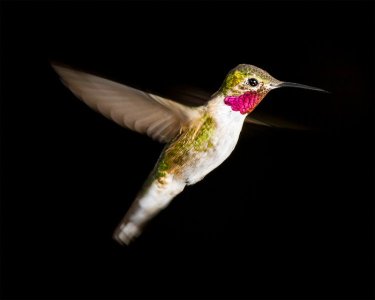
Canon 7D, 300mm, f/11, 1/250s, ISO 400
This was a hummingbird in my parent's backyard up in Colorado. There is a hummingbird feeder just to right of the bird. I set up two flashes on either side of where I expected the bird to hover. The background is black because the light from the flashes was much brighter than the distant woods behind the bird. The bird was so well lit compared to the woods that you can't even see them. I pushed the blacks down a little in post so that the black would look smoother.
Why did you shoot at 1/250s instead of a faster shutter speed?
That was the fastest flash sync speed for my camera. When you take a picture with a camera with a physical shutter, there are two shutter curtains that move. The first uncovers your sensor and the second curtain comes behind it and covers the sensor up again. That time between the two curtains is when the sensor records the picture. If you shoot faster than your camera's max flash sync speed, the second curtain starts to cover the sensor before the first curtain has fully uncovered it. Instead of having a period where the entire sensor is uncovered, the two curtains create a moving slit that passes over the picture. If they flash went off at some point during that process, only the part recorded through that slit would get light from the flash.
But your flash has a high speed sync you can use at faster shutter speeds. How does that work?
While the slit between the two curtains is moving, the flash pulses. It does this to make sure that each section gets light from flash. The faster the shutter speed you use, the smaller the slit between the first and second curtain, and the more times the flash has to pulse to light the entire scene. For a scene like this, that causes two problems. First, the amount of light the flash can generate decreases because it has to flash so many times in rapid succession. Second, the bird's wings will move slightly between each pulse, so even though you have a higher shutter speed, the wings will still show motion blur.
But I've seen pictures of hummingbirds with perfectly still wings. How did they do that?
They used a lot of flashes. The more flashes you use, the less light you need from any one of the flashes. Flashes only have one level of brightness. When you need the flash to be brighter, it stays on longer. If you have a bunch of flashes, none of them need to be very bright and so they can be on for a shorter period of time. What freezes the hummingbird isn't a fast shutter speed; it's the very short duration of the light from the flashes. For professional hummingbird shooters, I typically see about 5 flashes used on the hummingbird.
But the pictures I saw didn't have a black background. How did they light the background?
In theory, they could put the hummingbird feeder in the shade and have a brightly lit area behind it. But from what I've seen, most take an out-of-focus picture of a background, print it on a large sheet of non-reflective paper, put it behind where the hummingbird will be, and the light it with a couple more flashes.
But the pictures I saw looked like a natural setting and the hummingbird was sipping from a flower, not a feeder.
The photographer set out a feeder and got the hummingbirds accustomed to drinking from it. Then they added the background and the flash. Then they carefully covered the entrance to the feeder with a flower. If you were there when they took the picture, you'd see a bird flying into a bunch of flashes in front of a blurry picture drinking from a feeder tube covered with a flower. But in the picture, you see a hummingbird in standing out from an out-of-focus background drinking from a flower. People have been creating images that don't match reality long before Photoshop and MidJourney.
















 We call these our "glamour shots"
We call these our "glamour shots"  ; every little girl likes to do the "model pose" even when they're no longer "little".
; every little girl likes to do the "model pose" even when they're no longer "little". 

 ):
):



 ... it was time for DINNER!
... it was time for DINNER! 






 DGD spent 11 hours at the high school for dress rehearsal, Spring Show followed by Year End Banquet. Emotional evening and great show
DGD spent 11 hours at the high school for dress rehearsal, Spring Show followed by Year End Banquet. Emotional evening and great show  ...my favorite "scene"..."Chief of Police" informing Dora Director there had been a "prison escape" of "dangerous criminals'...followed by the mothers of the Brahmadoras as "prisoners"! LOVE their Director
...my favorite "scene"..."Chief of Police" informing Dora Director there had been a "prison escape" of "dangerous criminals'...followed by the mothers of the Brahmadoras as "prisoners"! LOVE their Director 

 and her clever ideas!
and her clever ideas!


